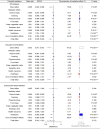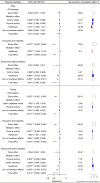Diabetes risk among US adults with different socioeconomic status and behavioral lifestyles: evidence from the National Health and Nutrition Examination Survey
- PMID: 37674682
- PMCID: PMC10477368
- DOI: 10.3389/fpubh.2023.1197947
Diabetes risk among US adults with different socioeconomic status and behavioral lifestyles: evidence from the National Health and Nutrition Examination Survey
Abstract
Background: Diabetes disproportionately affects minorities and those with low socioeconomic status (SES) in the United States, and differences in behavioral lifestyles are largely responsible for the unequal distribution of diabetes among different groups.
Methods: With data of 9,969 participants collected in the 2007-2008 and 2009-2010 cycles of the US National Health and Nutrition Examination Survey (NHANES), this study examined several mediators and their mediating effects in the connection between SES and the risk of diabetes. The SES is assessed by the income-to-poverty ratio (IPR), education level, and employment status. For the mediation analysis, we used health-related behaviors as mediators (smoking, alcohol use, consumption of green vegetables and fruits, physical activity and sedentary time, health insurance, and healthcare). In this study, the structural equation model was utilized to evaluate the mediating effects of behavioral lifestyle as a mediator in the relationship between SES and diabetes.
Results: A total of 9,969 participants were included in this study. We found a negative nonlinear association between IPR and diabetes risk (Poverall < 0.001; Pnon-linear = 0.46), which was independent of the majority of known or suspected risk factors and confounding variables (gender, age, race). Participants with lower SES had higher risk of diabetes compared with those with higher SES. In mediating analysis, we found alcohol intake (OR = 0.996), physical activity (OR = 0.993), health insurance (OR = 0.998), and healthcare (OR = 1.002) mediated the IPR-diabetes association. But in the relationship between education status and diabetes, the mediation effect of alcohol intake (OR = 0.995), physical activity (OR = 0.991), and health care (OR = 1.008) were obvious. Likewise, alcohol intake (OR = 0.996), fruit intake (OR = 0.998), and health care (OR = 0.975) were important mediators in the association between employment status and diabetes.
Conclusion: This study provides critical insights on the link between SES and diabetes. Our results highlight that poor health-related behaviors and limited access to healthcare are important pathways for increased diabetes risk related to those with low SES, particularly among Mexican Americans and males. They should be top priorities for agencies and healthcare providers to develop behavior-related interventions to reduce inequalities in diabetes risk.
Keywords: Mexican American; access to healthcare; behavioral factors; diabetes mellitus; socioeconomic status.
Copyright © 2023 Liu, He, Li, Yang, Zhang and Luo.
Conflict of interest statement
The authors declare that the research was conducted in the absence of any commercial or financial relationships that could be construed as a potential conflict of interest.
Figures





Similar articles
-
Associations of healthy lifestyle and socioeconomic status with mortality and incident cardiovascular disease: two prospective cohort studies.BMJ. 2021 Apr 14;373:n604. doi: 10.1136/bmj.n604. BMJ. 2021. PMID: 33853828 Free PMC article.
-
Mediators of the association between low socioeconomic status and chronic kidney disease in the United States.Am J Epidemiol. 2015 Mar 15;181(6):385-96. doi: 10.1093/aje/kwu316. Epub 2015 Mar 1. Am J Epidemiol. 2015. PMID: 25731886 Free PMC article.
-
Socioeconomic status and sleep duration among a representative, cross-sectional sample of US adults.BMC Public Health. 2024 Dec 18;24(1):3410. doi: 10.1186/s12889-024-20977-w. BMC Public Health. 2024. PMID: 39695529 Free PMC article.
-
Socioeconomic status and sleep health: a narrative synthesis of 3 decades of empirical research.J Clin Sleep Med. 2023 Mar 1;19(3):605-620. doi: 10.5664/jcsm.10336. J Clin Sleep Med. 2023. PMID: 36239056 Free PMC article. Review.
-
The influence of socioeconomic status on the association between unhealthy lifestyle factors and adverse health outcomes: a systematic review.Wellcome Open Res. 2023 Dec 8;8:55. doi: 10.12688/wellcomeopenres.18708.2. eCollection 2023. Wellcome Open Res. 2023. PMID: 38533439 Free PMC article.
Cited by
-
Exploring socioeconomic status, lifestyle factors, and cardiometabolic disease outcomes in the United States: insights from a population-based cross-sectional study.BMC Public Health. 2024 Aug 12;24(1):2174. doi: 10.1186/s12889-024-19685-2. BMC Public Health. 2024. PMID: 39134948 Free PMC article.
-
More schooling is associated with lower hemoglobin A1c at the high-risk tail of the distribution: an unconditional quantile regression analysis.BMC Public Health. 2025 Jun 3;25(1):2062. doi: 10.1186/s12889-025-23063-x. BMC Public Health. 2025. PMID: 40462031 Free PMC article.
-
Making the Most of Familismo to Curb the Diabetes Epidemic: Early Evidence of Success Delivering the Same Intervention to Latinas at Risk for and With Diabetes.Clin Med Insights Endocrinol Diabetes. 2024 Sep 14;17:11795514241274696. doi: 10.1177/11795514241274696. eCollection 2024. Clin Med Insights Endocrinol Diabetes. 2024. PMID: 39291260 Free PMC article.
-
Addressing the Diabetes Tsunami Requires Expanded Access to Diabetes Technologies.J Diabetes Sci Technol. 2025 Apr 10:19322968251332956. doi: 10.1177/19322968251332956. Online ahead of print. J Diabetes Sci Technol. 2025. PMID: 40207786 Free PMC article.
-
Analysis of the management and therapeutic performance of diabetes mellitus employing special target.World J Diabetes. 2023 Dec 15;14(12):1721-1737. doi: 10.4239/wjd.v14.i12.1721. World J Diabetes. 2023. PMID: 38222785 Free PMC article. Review.
References
-
- Saeedi P, Petersohn I, Salpea P, Malanda B, Karuranga S, Unwin N, et al. . Global and regional diabetes prevalence estimates for 2019 and projections for 2030 and 2045: results from the international diabetes federation diabetes atlas, 9(th) edition. Diabetes Res Clin Pract. (2019) 157:107843. doi: 10.1016/j.diabres.2019.107843. PMID: - DOI - PubMed
-
- National Center for Chronic Disease Prevention and Health Promotion . Division of diabetes translation at a glance. (2022). Available at: https://www.cdc.gov/chronicdisease/resources/publications/aag/diabetes.htm.
Publication types
MeSH terms
LinkOut - more resources
Full Text Sources
Medical

